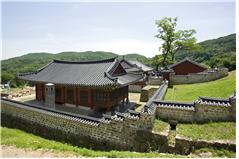
Temporary Palace at Namhansanseong Fortress (Historic Site)A temporary palace, called a haenggung in Korean, was used by Joseon’s kings as a temporary residence whenever they had to travel outside the royal capital. Built in 1625, the fourth year of the reign of King Injo of Joseon, the temporary palace at Namhansanseong Fortress was designed to serve as the provisional capital during times of emergency, such as war or rebellion, until reinforcements arrived. Indeed, during the Qing invasion of Joseon in 1636, King Injo occupied this temporary palace for forty-seven days. Later kings, including Sukjong, Yeongjo, Jeongjo, Cheoljong, and Gojong, stopped here on their way to visit the tombs of their predecessors in Yeoju and Icheon, etc. The Temporary Palace was preserved well until 1909, but it was badly damaged by the Japanese authorities during the Japanese colonial period. The first archaeological surveys of this were conducted in 1999, and Naehaengjeon Hall, the main building of the upper palace, was rebuilt in 2002, while Jwajeon Shrine at the Temporary Palace was rebuilt in 2004.